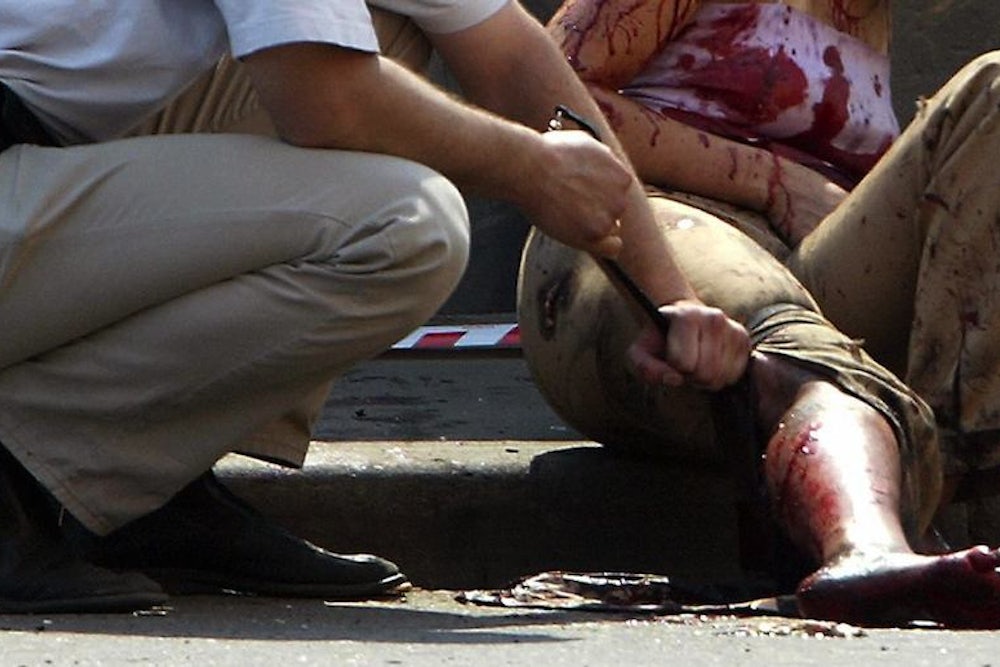A decade after the invasion of Iraq, it seems pretty clear that the ensuing military adventures there and in Afghanistan have done more harm than good. Billions of dollars were spent, thousands of lives lost, and two regions are now no more stable than when we arrived.
But yesterday's tragedy in Boston has given us one reason to be grateful: the tourniquet.
After two pressure-cooker bombs sent shrapnel through the crowd at the marathon's finish line—much like the IEDs that have claimed so many soldiers' lives—there was much talk of lost limbs. A day after the attacks, though, only a few had actually been amputated: four at Massachusetts General Hospital, five at Boston Medical Center, and one at Brigham and Women's Hospital. The total casualty count was even lower, at only three deaths so far. Those who survived could have tourniquets to thank: Reports indicate that first responders used belts, lanyards, ripped clothes, and even brand-new clothes to bind the wounds of blast victims.
Only a few weeks ago, a group of officials from the FBI, American College of Surgeons, and police and fire organizations published the "Hartford Consensus" on how to respond to mass casualty events such as the shooting in Newtown, Connecticut. Its primary conclusion: The number one cause of preventable death in these situations is blood loss, and the best way to stop blood loss is to properly apply a tourniquet.
You wouldn't think that fact would need reiteration. But tourniquets went out of style long ago, and only recently have made a comeback. According to the American Journal of Surgery, they were effectively banned after World War II, when botched applications—bands tied too tightly, or too loose—led to more deaths and limbs lost, not fewer. Tourniquets were then used only occasionally in the Korean and Vietnam Wars; later studies showed that they could have prevented between seven and 19 percent of deaths in Vietnam.
The military first started to come around on tourniquets in the 1990s, when special forces in Somalia found that using them correctly saved several lives. Finally, in 2003, new tourniquet designs were tested for combat operations in Iraq and recommended for standard issue to soldiers. A 2008 study from a Baghdad hospital found that the survival rate with tourniquet use was 87 percent.
Now, tourniquets are gradually making their way back into civilian emergency medicine as well. Mayo Clinic Trauma Center medical director Donald Jenkins, who retired from a 24-year career in the Air Force in 2008 and now heads the National Trauma Institute, estimates that a little over half of ambulances now carry tourniquets and properly train staff to use them.
"After decades of preaching that tourniquets are evil, you could see how it would take time for something like this to sink in," Jenkins says. "Tourniquets saved lives in this Boston bombing, and it's going to increase the use of them elsewhere."
As it happens, researchers at Boston Medical Center had already taken note of the tide turning towards tourniquet on the battlefield, and conducted a study on civilian shooting victims between 1999 and 2006 that came to a similar conclusion: When used properly, tourniquets work, and more first responders should use them. The study's author, Jeffrey Kalish, says that many local ambulances at least carry rubber tubing for that purpose.
Neither Boston Medical Center nor Boston Emergency Medical Services have responded to queries about how tourniquets were used after the marathon bombings, so we can't yet confirm their effectiveness. It wouldn't be the first time, though, that killing abroad has saved lives at home: Wartime medical advances have long translated into civilian life (trauma centers full of specialists sprouted up in cities, for examples, after they’d worked to great effect in Vietnam). America's latest conflicts have also improved techniques to repair tissues and nerves that have prevented amputations in operating rooms around the country.
That kind of research funding tends to dry up when the soldiers come home. But hundreds of thousands of people die from traumatic injuries every year, and Jenkins says that huge gaps still remain in our knowledge of how to treat them. The National Trauma Institute has been campaigning for more money to research trauma, which doesn't loom as large in the public consciousness as many diseases do.
"We've spent millions on HIV/AIDS and breast cancer, and are seeing survival rates you can't believe. People are surviving to far greater extents today because we have stroke and coronary centers that have proven through randomized trials what works," Jenkins says. "That's all waiting to happen in trauma. You can solve the problem, and we can learn a lot, we just have to apply the resources to do it. We just can't get anybody's attention that this is a huge problem."
Maybe Boston will create that kind of attention. Domestic acts of mass violence seem to be the threat of this decade, after all, and we shouldn’t need a war to stop the bleeding.
